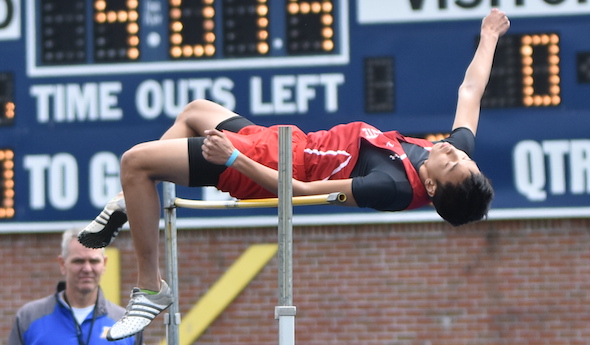
Marquette Pushes Title Run to 3 Straight
By
John Vrancic
Special for MHSAA.com
June 3, 2017
KINGSFORD — The Marquette boys quietly went about their business Saturday and were rewarded with their third straight Upper Peninsula Division 1 track & field title.
Marquette collected 128 points. Iron Mountain edged Houghton 76½-73 for the runner-up trophy, and Kingsford was fourth at 61.
The Redmen grabbed the top three places in high jump, with Jedidiah Weber leading the way at 6 feet, 2 inches. Raphael Millado took second and Taylor Althouse was third, both clearing six feet.
“That was huge for us,” said Marquette senior Alex DuVall, who anchored the winning 1,600-meter relay. “We have a lot of young guys. The future looks pretty good. Houghton, Kingsford and Iron Mountain have a lot of good runners. It feels good to bring the title home again.”
Senior Wyatt Goodwin added a first in long jump (20-2), and DuVall helped the Redmen take second in the 400 and 800 relay at 45.30 seconds and 1:35.23, respectively. They were clocked at 3:31.33 in the 1,600.
DuVall, who plans to play football and basketball at Lawrence University in Appleton, Wis., in 2017-18, added a fourth place in the 100 (11.74).
“We ran our best time all year in the 1,600 relay,” he added. “Our handoffs went real well. We’ve been working on handoffs in practice, and we’ve got them down.”
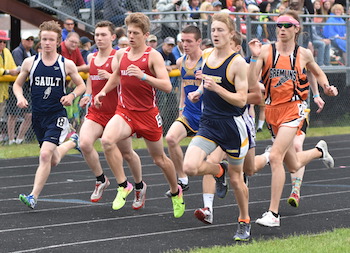 Iron Mountain’s Aaron Bolo won the 110 hurdles (15.79), followed by teammate Charlie Gerhard (15.86) and Marquette senior Collin Shinners (15.89).
Iron Mountain’s Aaron Bolo won the 110 hurdles (15.79), followed by teammate Charlie Gerhard (15.86) and Marquette senior Collin Shinners (15.89).
The Mountaineers captured the 800 relay (1:34.48). Gerhard took the 300 hurdles (41.34), and Bolo was runner-up in long jump (20-0).
Junior Clayton Sayen paced Houghton with victories in the 200 (22.63) and 400 (50.24) and by anchoring the winning 3,200 relay (8:15.7). Kamron Simpkin added a victory in pole vault (12-9).
Kingsford senior Trevor Roberts captured the 100 (11.25), anchored the winning 400 relay (45.25) and took second in the 200 (23.21) and third in long jump (19-6½).
“This was a rebuilding year for us,” said Kingsford coach Doug Roberts. “We lost quite a few seniors last year. Marquette has a real good team. Yes, they’re a bigger school. But they have quality athletes and coaches. Hats off to them.”
Negaunee junior Colton Yesney won the 1,600 (4:24.81). Marquette junior Garrett Rudden was runner-up (4:30.49) and Sault Ste. Marie senior Ryan Sanderson (4:34.70) squeezed past Gladstone sophomore Adam Bruce by two hundredths of a second for third.
Sanderson took the 800 (2:01.35), edging Yesney by a half-second.
“He (Yesney) is a good runner,” said Sanderson, who’s attending Michigan State on an academic scholarship this fall. “He ran a great mile. I’ve been here for four years and waited and waited to get one (U.P. title). Now that I got one, it’s a great feeling. It has been a great ride.”
Bruce earned his first U.P. title in the 3,200 (10:20.00), followed by Yesney (10:22.63), Rudden (10:28.43) and Houghton’s Seth Helman (10:28.62).
“I’m super happy,” said Bruce. “I wasn’t going to run the 3,200 this year.
“I can’t ask for a better team. We’re a family. We get along real well. I really enjoy running for Mr. (Gary) Whitmer. He makes it fun.”
PHOTOS: (Top) Marquette's Raphael Millado lays out over the high jump bar; he finished second in the event. (Middle) A pack of contenders stays close during the 1,600. (Photos by Cara Kamps.)
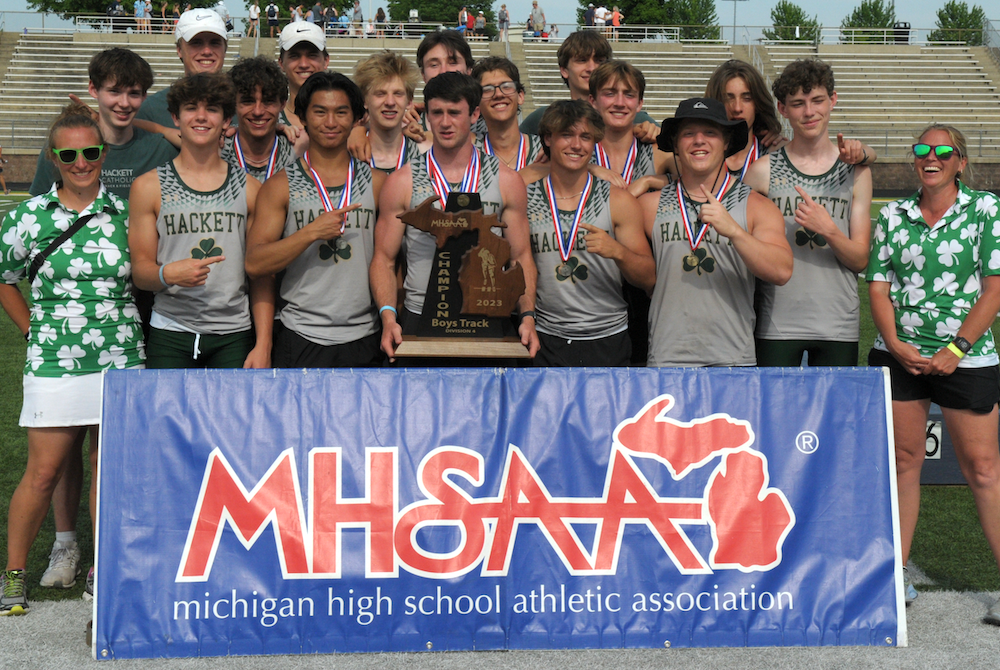
Thrower Claims Lone Individual Title to Lead Hackett to Team 3-Peat
By
Tom Lang
Special for MHSAA.com
June 3, 2023
Kalamazoo Hackett Catholic Prep just keeps winning and winning.
This time the Irish took home their fourth title in the last five Lower Peninsula Division 4 Track & Field Finals, on Saturday at Hudsonville.
Hackett’s only individual title was taken by discus winner Nathan Buchmann, a senior, who was fine knowing he was the shortest in stature among all the sizable competitors.
“In the offseason after football I worked out every day, working towards this goal,” he said after getting his medal. “I would say this takes 80 percent technique and 20 percent strength to throw the discus. So, length can help but if you have good technique and are really strong, that will play into it.
“I think we are very balanced throughout the meet today,” he said about teammates that scored points in finishes other than first place. “We have 13 guys here today, and we have people in a lot of the races. But I do not run; I have too short of legs to be a fast runner,” he said with a chuckle.
Buchmann had to work through a hip injury to compete this spring.
“I think the setbacks are what make you strong,” he said. “You can either give up through the setbacks or push forward and become better.”
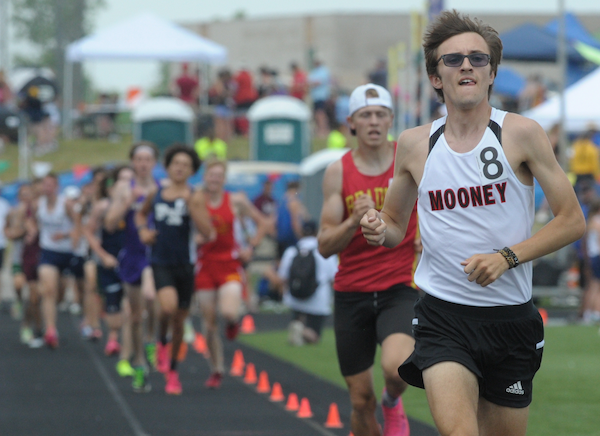 Coach Charissa Dean agreed.
Coach Charissa Dean agreed.
“The kids have big hearts,” she said after all the points were totaled and the Irish were on top once again, with 53. “They worked hard. They had a lot of potential when we started the season. And we had a lot of drive to put in the work, and we are happy the results came out the way they did.”
Reading was runner-up at 47 points, followed by Wyoming Potter’s House Christian with 42, then Fowler and Flint Beecher each with 37 points.
Senior Lezawe “Moses” Osterink, of Potter’s House Christian, placed second in 1,600 but took the 3,200 title as defending champ of both. He dominated the latter by lapping the field with a final lap kick that resembled more of a superhero speedster.
“Nobody really took it out that hard at the start,” he said. “There was a freshman (Marek Butkiewicz of Hackett) that tried to get the pace going quick, but me and Dakota (Dykhuis of Montabella) just kind of sat back and gradually pulled him through.
“We took it gradually, and I was just relying that I could kick.”
Kick did he ever. The trio were neck and neck the majority of the race in a grouping ahead of the pack.
“With 400 to go I just tried to go all out,” Osterink said. “I had a lot more left than I thought and I was pleased with the win. Not really the time, but that doesn’t matter, especially this hot out.”
The overall meet was in the low 90s/high 80s heat and searing sun all day. So, race officials allowed the unique opportunity for coaches to spray the runners with water and give them water bottles.
“It was very weird because I’ve never taken water to drink while I’m running, so I didn’t know how that would feel,” Osterink said. “And they were spraying us and hitting us in the face. It was kind of fun.”
Junior Tyler Lenn of Marine City Cardinal Mooney defeated Osterink at his own game in the 1,600.
“I’m feeling great,” Lenn said after grabbing the medal. “I said to a newspaper after one of my races (during the season) I was right where I wanted to be. This has been a long rebuilding process for me since an injury back in the fall, and I set a pretty high goal the day the injury happened. I was telling myself I needed to fulfill what I said I would do at the beginning of last cross country season. And that is what I did today.”
Lenn suffered an ankle sprain from a misstep that turned worse because he kept running through the season on it.
“Coming back from that was pretty tough, but I wouldn’t have it any other way,” he said. 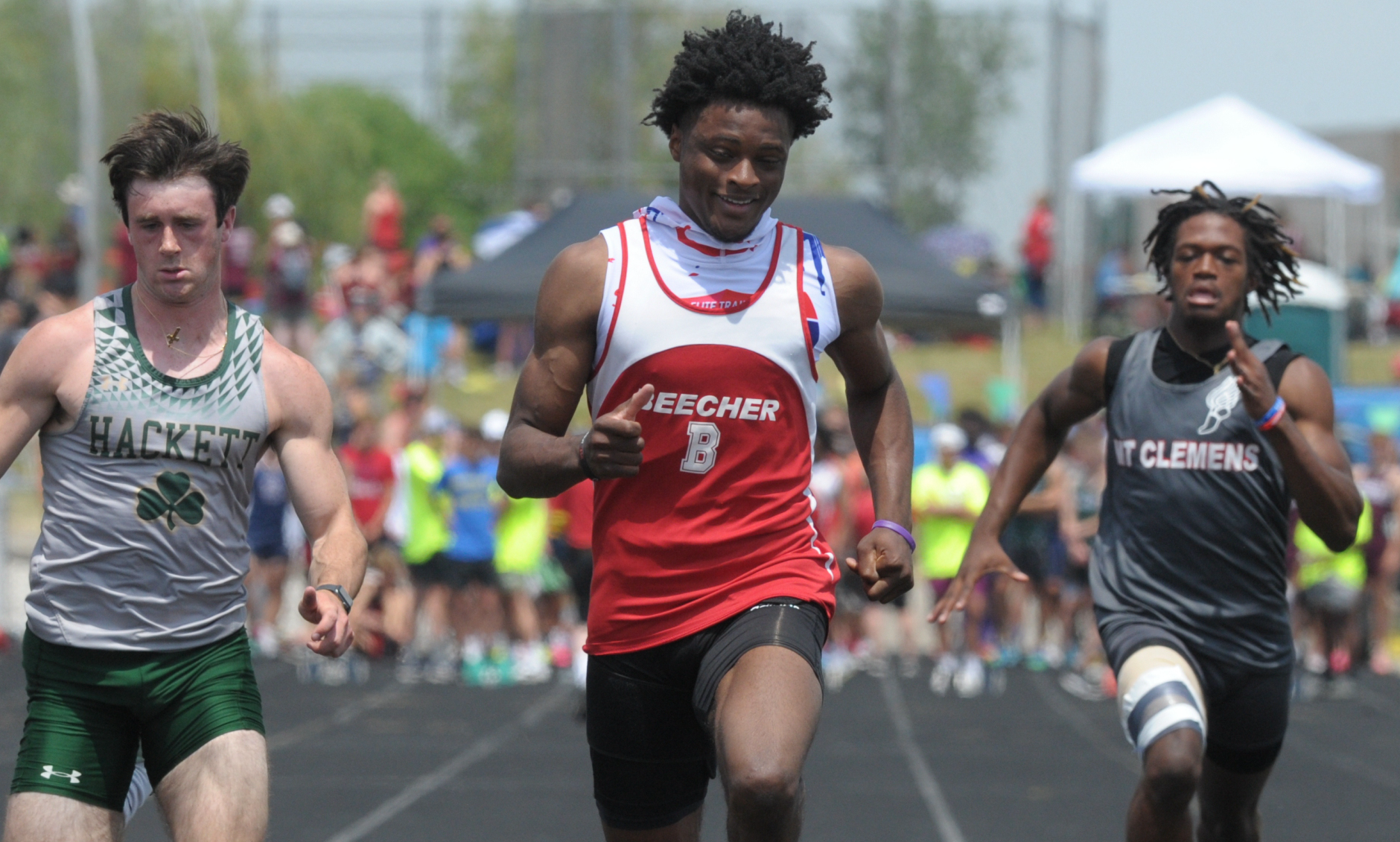 “Perseverance; I said from the beginning what I was going to do. I kept my eye on that target, and no matter the circumstances life threw at me, that I was going to make it happen and I am a man of my word.”
“Perseverance; I said from the beginning what I was going to do. I kept my eye on that target, and no matter the circumstances life threw at me, that I was going to make it happen and I am a man of my word.”
Jaylin Townsend, a senior from Flint Beecher, dominated the short races. He won the 100 dash (10.67) and 200 dash at 22 seconds flat. It was his third 100 win at a Finals.
“I put in a lot of work; I had to three-peat,” he said after the 100. “There’s a lot of great competition here, so I knew I had to come out and run my best.”
Concord in the 400 (43.72), Buckley in the 800 (1:30.76) and 1,600 (3:29.13) and Potter’s House in the 3,200 (8:14.18) were relay champs Saturday. Reading’s Tayshawn Bester won the 110 hurdles (15.13), and Athens’ Landen Bennett won the 300 (39.85). Caseville’s Nathan Feltner won the 400 (50.76), and Vestaburg’s Owen Patton claimed the 800 (1:55.11).
Fruitport Calvary Christian’s Bradley Richards won the high jump (6-10), and Peck’s Alex Affer won the long jump (23-4). McBain Northern Michigan Christian’s Isaac Bowden was first in pole vault (13-0), and Brown City’s Kyle Affer won shot put (49-2).
PHOTOS (Top) Kalamazoo Hackett Catholic Prep celebrates its third-straight LPD4 title Saturday. (Middle) Cardinal Mooney's Tyler Lenn, far right, sets the pace in the 1,600. (Below) Flint Beecher's Jaylin Townsend, middle, crosses the finish first for one of his two sprint championships. (Photos by Ken Swart/RunMichigan.com.)

